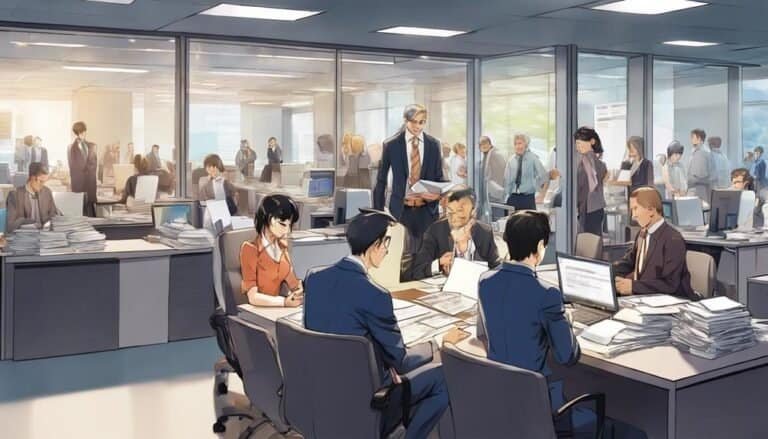Job Duties for Industrial Designer
In the fast-paced world of industrial design, professionals are tasked with a multitude of responsibilities that range from the inception of ideas to their tangible realization. From conducting thorough research and analysis to collaborating with cross-functional teams, the role demands a diverse skill set and a keen eye for detail.
However, what truly sets industrial designers apart is their ability to seamlessly blend creativity with practicality, resulting in innovative solutions that shape our everyday experiences. Understanding the intricacies of this dynamic field goes beyond the domain, delving into a territory where creativity meets functionality to create impactful designs that resonate with users.
Key Takeaways
- Research and trend analysis drive innovative creations and product designs.
- Collaboration and material selection ensure technical feasibility and aesthetic appeal.
- Cost-effective material options focus on quality, sustainability, and competitive pricing.
- Presentation and communication skills are essential for client engagement and stakeholder buy-in.
Research and Analysis
In the domain of industrial design, the foundational pillar of Research and Analysis serves as the compass guiding designers towards innovative and purposeful creations. Market research and trend analysis play a pivotal role in identifying consumer needs, preferences, and emerging patterns in the industry. By delving deep into market research, industrial designers gain valuable insights that enable them to create products that resonate with target audiences and stand out in the competitive market landscape.
Additionally, user experience (UX) and usability testing form integral components of Research and Analysis in industrial design. Understanding how users interact with products, their pain points, and preferences is essential for designing functional and user-friendly solutions. Usability testing allows designers to refine their creations based on real-world feedback, ensuring that the final product not only meets aesthetic standards but also excels in terms of practicality and ease of use.
Research and Analysis empower industrial designers to make informed decisions, foster innovation, and ultimately deliver products that exceed expectations both in form and function.
Ideation and Sketching
Exploring diverse concepts and translating abstract ideas into visual representations through sketching are fundamental stages in the creative process of industrial design. This phase involves brainstorming techniques to generate innovative ideas and concept development to refine and enhance these ideas.
Here are four key aspects that industrial designers focus on during the ideation and sketching process:
- Brainstorming Techniques: Industrial designers employ various brainstorming methods such as mind mapping, word association, and SCAMPER (Substitute, Combine, Adapt, Modify, Put to another use, Eliminate, Reverse) to stimulate creativity and generate a wide range of concepts.
- Concept Development: Once initial ideas are generated, designers work on developing these concepts further through sketching. This involves creating rough sketches, renderings, and detailed drawings to visualize the product design from different perspectives.
- Iterative Process: Ideation and sketching often involve an iterative approach, where designers continually refine and iterate on their initial concepts based on feedback and evaluation.
- Visualization: Sketching plays an important role in visualizing ideas and communicating design concepts to clients, team members, and stakeholders effectively. It helps in conveying the essence of the design and its functionality before moving on to the prototyping phase.
3D Modeling and Prototyping
Utilizing advanced digital modeling software and prototyping techniques is a pivotal aspect of the industrial design process, allowing designers to bring their concepts to life in a tangible and interactive manner. 3D modeling plays a critical role in visualizing and refining designs before moving into the prototyping phase. Designers use specialized software to create detailed virtual models that can be viewed from different angles, manipulated, and tested for functionality. This process helps identify potential flaws and streamline the overall design before investing in physical prototypes.
Rapid prototyping technologies further enhance the design process by enabling quick and cost-effective creation of physical models based on the digital designs. Through techniques like 3D printing, designers can produce functional prototypes that closely resemble the final product, allowing for hands-on testing and evaluation. This iterative approach facilitates faster design iterations, feedback incorporation, and ultimately results in more refined and successful final products. The seamless integration of 3D modeling and rapid prototyping elevates the industrial designer's ability to innovate and bring innovative ideas to fruition.
Collaboration With Engineers
To excel in the field of industrial design, fostering a strong partnership with engineers is paramount. This collaboration guarantees a seamless integration of technical aspects into the creative design process.
Design-Engineer Partnership
In the dynamic field of industrial design, fostering a strong design-engineer partnership is essential for ensuring the seamless integration of creative concepts with technical feasibility.
This collaboration benefits both parties by leveraging their respective expertise to achieve best results. The design process improvements seen through this partnership include enhanced problem-solving abilities, streamlined communication channels, and a more efficient workflow.
Technical Integration Approach
A synergistic technical integration approach with engineers is pivotal in the industrial design process to harmonize creative vision with practical implementation. Design innovation thrives when industrial designers collaborate closely with engineers, ensuring that aesthetic concepts align seamlessly with technical feasibility.
By working hand-in-hand with engineers, industrial designers can navigate the complexities of manufacturing processes, optimizing product designs for efficiency and effectiveness. This partnership allows for the exploration of new materials, production methods, and technologies, pushing the boundaries of what is possible in product development.
Through this technical integration approach, industrial designers can leverage the expertise of engineers to create innovative designs that not only look impressive but also function seamlessly in real-world applications.
Material Selection and Testing
When it comes to the role of an industrial designer, a vital aspect is the selection of practical materials that align with the product's design and function.
Additionally, understanding performance testing procedures is essential to ascertain the durability and quality of the final product.
Industrial designers must also possess the skill to identify cost-effective material options that meet both budgetary constraints and project requirements.
Practical Material Choices
Crafting a successful industrial design often hinges on the meticulous process of selecting and testing practical materials to guarantee functionality and aesthetic appeal. When making practical material choices for industrial design, consider the following:
- Material Selection: Understanding the properties and characteristics of different materials is critical for choosing the right one for the design.
- Manufacturing Processes: Knowledge of manufacturing techniques helps in selecting materials that are compatible with the chosen production methods.
- Cost-Effectiveness: Balancing quality and cost is essential to make sure the design remains economically viable.
- Environmental Impact: Considering the environmental sustainability of materials aligns with modern design principles and consumer preferences.
Performance Testing Procedures
In the domain of industrial design, a pivotal aspect following practical material choices is the implementation of rigorous performance testing procedures to make certain the selected materials meet the design's functional requirements seamlessly. Product performance and usability testing are integral parts of this phase, ensuring that the product functions as intended and provides a positive user experience.
Failure analysis is conducted meticulously to identify weaknesses or potential points of failure in the design, allowing for necessary improvements before production. Quality assurance measures are put in place to guarantee that the materials selected not only meet the design specifications but also adhere to industry standards for durability and safety.
Through these meticulous testing procedures, industrial designers can create products that excel in both form and function.
Cost-Effective Material Options
For industrial designers aiming to optimize cost-effectiveness in material selection and testing, strategic analysis of material properties and performance characteristics is paramount in achieving a balance between quality and affordability.
When considering cost-effective material options, designers should explore the following:
- Budget-Friendly Options: Researching and sourcing materials that offer a competitive price point without guaranteeing quality.
- Sustainable Alternatives: Exploring eco-friendly materials that not only reduce costs in the long term but also align with environmentally conscious practices.
- Performance Testing: Conducting thorough testing to make sure the selected materials meet quality standards and performance requirements.
- Lifecycle Analysis: Evaluating the overall lifecycle costs of materials to make informed decisions on long-term affordability and sustainability.
Presentation and Communication Skills
Possessing exceptional presentation and communication skills is paramount for industrial designers as they navigate the intricate process of conveying their design concepts effectively to clients and stakeholders. Public speaking skills are essential for articulating ideas clearly and persuasively during client meetings, design pitches, and project updates. Industrial designers must master the art of delivering effective presentations that not only showcase the design rationale but also address potential concerns and highlight the unique selling points of their creations.
Additionally, visual communication plays an important role in capturing the attention of the audience and conveying complex ideas in a clear and concise manner. Utilizing storytelling techniques can help designers create compelling narratives around their designs, engaging clients on an emotional level and fostering a deeper connection to the product. By honing their presentation and communication skills, industrial designers can effectively communicate their vision, gain buy-in from stakeholders, and ultimately bring their innovative designs to life.
Design Refinement and Iteration
Mastering the art of refining and iterating design concepts is a fundamental aspect of an industrial designer's creative process, shaping the evolution of ideas into tangible innovations. This process involves a series of structured steps that guarantee the final design meets the needs and expectations of the end-users:
- Design Critique and Feedback Loop: Industrial designers engage in rigorous critique sessions where concepts are evaluated based on criteria such as functionality, aesthetics, and manufacturability. Feedback loops are essential for gathering insights from team members and stakeholders, guiding the refinement process.
- User Testing and Validation Process: Conducting user testing sessions allows designers to observe how individuals interact with prototypes, identifying pain points and areas for improvement. Validation through user feedback is essential for refining designs to align with user needs and preferences.
- Iterative Prototyping: Designers create multiple iterations of a concept, gradually refining and enhancing its features based on feedback and testing results. This iterative approach enables continuous improvement and guarantees the final product meets design objectives.
- Cross-Disciplinary Collaboration: Collaboration with engineers, marketers, and other professionals throughout the refinement process ensures that design solutions are technically feasible, marketable, and aligned with business goals.
Conclusion
To sum up, the job duties of an industrial designer encompass a wide range of tasks, from research and analysis to collaboration with engineers and design refinement.
This role requires creativity, attention to detail, and innovative thinking to develop innovative products that meet the needs of consumers.
Industrial designers play a vital role in shaping the future of design and transforming ideas into reality, making them the unsung heroes of the product development process.







